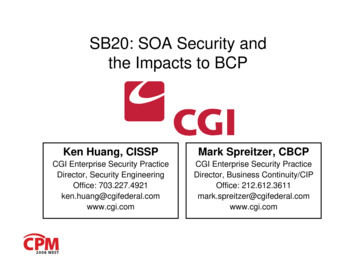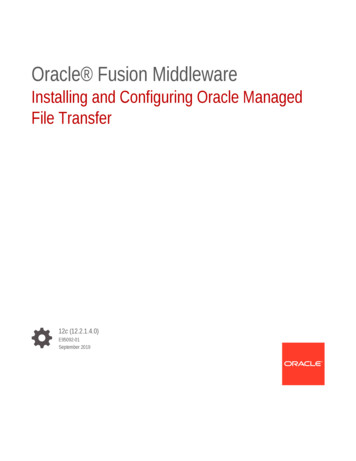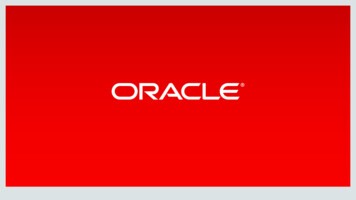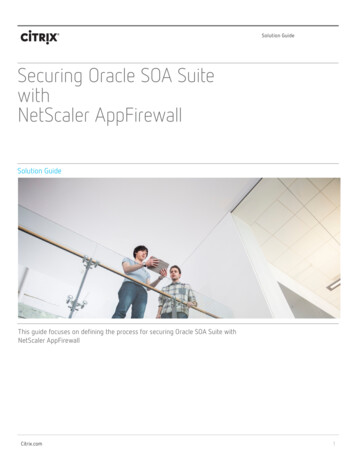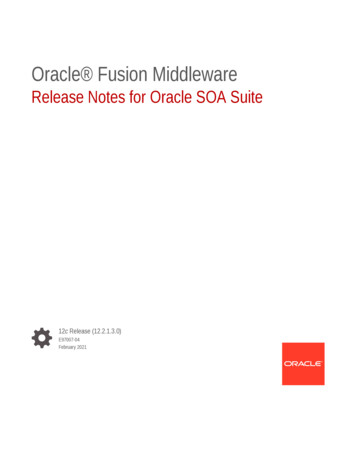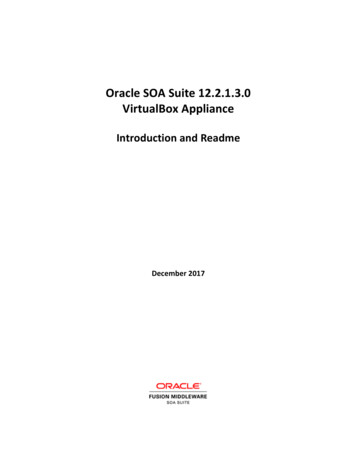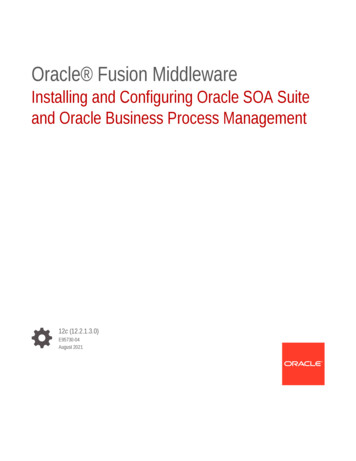
Transcription
Oracle Fusion MiddlewareInstalling and Configuring Oracle SOA Suiteand Oracle Business Process Management12c (12.2.1.3.0)E95730-04August 2021
Oracle Fusion Middleware Installing and Configuring Oracle SOA Suite and Oracle Business ProcessManagement, 12c (12.2.1.3.0)E95730-04Copyright 2009, 2021, Oracle and/or its affiliates.Primary Author: Oracle CorporationThis software and related documentation are provided under a license agreement containing restrictions onuse and disclosure and are protected by intellectual property laws. Except as expressly permitted in yourlicense agreement or allowed by law, you may not use, copy, reproduce, translate, broadcast, modify, license,transmit, distribute, exhibit, perform, publish, or display any part, in any form, or by any means. Reverseengineering, disassembly, or decompilation of this software, unless required by law for interoperability, isprohibited.The information contained herein is subject to change without notice and is not warranted to be error-free. Ifyou find any errors, please report them to us in writing.If this is software or related documentation that is delivered to the U.S. Government or anyone licensing it onbehalf of the U.S. Government, then the following notice is applicable:U.S. GOVERNMENT END USERS: Oracle programs (including any operating system, integrated software,any programs embedded, installed or activated on delivered hardware, and modifications of such programs)and Oracle computer documentation or other Oracle data delivered to or accessed by U.S. Government endusers are "commercial computer software" or "commercial computer software documentation" pursuant to theapplicable Federal Acquisition Regulation and agency-specific supplemental regulations. As such, the use,reproduction, duplication, release, display, disclosure, modification, preparation of derivative works, and/oradaptation of i) Oracle programs (including any operating system, integrated software, any programsembedded, installed or activated on delivered hardware, and modifications of such programs), ii) Oraclecomputer documentation and/or iii) other Oracle data, is subject to the rights and limitations specified in thelicense contained in the applicable contract. The terms governing the U.S. Government’s use of Oracle cloudservices are defined by the applicable contract for such services. No other rights are granted to the U.S.Government.This software or hardware is developed for general use in a variety of information management applications.It is not developed or intended for use in any inherently dangerous applications, including applications thatmay create a risk of personal injury. If you use this software or hardware in dangerous applications, then youshall be responsible to take all appropriate fail-safe, backup, redundancy, and other measures to ensure itssafe use. Oracle Corporation and its affiliates disclaim any liability for any damages caused by use of thissoftware or hardware in dangerous applications.Oracle, Java, and MySQL are registered trademarks of Oracle and/or its affiliates. Other names may betrademarks of their respective owners.Intel and Intel Inside are trademarks or registered trademarks of Intel Corporation. All SPARC trademarks areused under license and are trademarks or registered trademarks of SPARC International, Inc. AMD, Epyc,and the AMD logo are trademarks or registered trademarks of Advanced Micro Devices. UNIX is a registeredtrademark of The Open Group.This software or hardware and documentation may provide access to or information about content, products,and services from third parties. Oracle Corporation and its affiliates are not responsible for and expresslydisclaim all warranties of any kind with respect to third-party content, products, and services unless otherwiseset forth in an applicable agreement between you and Oracle. Oracle Corporation and its affiliates will not beresponsible for any loss, costs, or damages incurred due to your access to or use of third-party content,products, or services, except as set forth in an applicable agreement between you and Oracle.
ContentsPreface1AudiencexDocumentation AccessibilityxRelated DocumentsxConventionsxiAbout the Oracle SOA Suite and Oracle Business Process ManagementInstallationAbout Installing a Development Environment1-1Using the Standard Installation Topology as a Starting Point1-1About the Oracle SOA Suite Standard Installation Topology1-2About the Oracle Business Process Management Standard Installation Topology1-3About the Oracle Business Activity Monitoring Standard Installation Topology1-4About the Oracle Real-Time Integration Business Insight Standard Installation Topology1-6About Elements in the Standard Installation Topology Illustration1-7About Secondary TopologiesAbout Installing Oracle User Messaging Service1-9About Installing Oracle Business Process Management Standalone1-9About Installing Oracle Enterprise Scheduler1-9About Installing Oracle Business Process Management and Oracle ApplicationDevelopment FrameworkUsing This Document to Extend an Existing Domain21-81-101-10Preparing to Install and Configure Oracle SOA Suite and OracleBusiness Process ManagementRoadmap for Installing and Configuring a Standard Installation Topology2-1Roadmap for Verifying Your System Environment2-2Verifying Certification, System, and Interoperability Requirements2-3Selecting an Installation User2-4About User Permissions2-4About Non-Default User Permissions on UNIX Operating Systems2-6iii
Verifying that the Installation User has Administrator Privileges on WindowsOperating Systems2-7About the Directories for Installation and Configuration2-7About the Recommended Directory Structure2-8About the Oracle Home Directory2-9About the Domain Home Directory2-9About the Application Home Directory2-10Installing Multiple Products in the Same Domain2-10Preparing for Shared Storage2-11About JDK Requirements for an Oracle Fusion Middleware Installation2-11About Database Requirements for an Oracle Fusion Middleware Installation2-12About the Custom Variables Required for the SOA Suite Schemas342-12About Product Distributions2-14Obtaining the Product Distribution2-14Installing the Oracle SOA Suite and Oracle Business ProcessManagement SoftwareVerifying the Installation Checklist3-1Starting the Installation Program3-3Navigating the Installation Screens3-3Verifying the Installation3-4Reviewing the Installation Log Files3-5Checking the Directory Structure3-5Viewing the Contents of the Oracle Home3-5Configuring Oracle SOA Suite DomainCreating the Database Schemas4-1Installing and Configuring a Certified Database4-2Starting the Repository Creation Utility4-2Navigating the Repository Creation Utility Screens to Create Schemas4-2Introducing the RCU4-3Selecting a Method of Schema Creation4-3Providing Database Connection Details4-3Specifying a Custom Prefix and Selecting Schemas4-4Specifying Schema Passwords4-5Specifying Custom Variables4-5Completing Schema Creation4-5Configuring the Domain4-5Starting the Configuration Wizard4-5Navigating the Configuration Wizard Screens to Create and Configure the Domain4-6iv
Selecting the Domain Type and Domain Home Location4-8Selecting the Configuration Template for Oracle SOA Suite4-8Configuring High Availability Options4-8Selecting the Application Home Location4-9Configuring the Administrator Account4-10Specifying the Domain Mode and JDK4-10Specifying the Database Configuration Type4-10Specifying JDBC Component Schema Information4-11Testing the JDBC Connections4-12Selecting Advanced Configuration4-12Configuring the Administration Server Listen Address4-12Configuring Node Manager4-13Configuring Managed Servers for Oracle SOA Suite4-13Configuring a Cluster for Oracle SOA Suite4-14Defining Server Templates4-14Configuring Dynamic Servers4-14Assigning Oracle SOA Suite Managed Servers to the Cluster4-15Configuring Coherence Clusters4-15Creating a New Oracle SOA Suite Machine4-16Assigning Servers to Oracle SOA Suite Machines4-16Virtual Targets4-17Partitions4-17Reviewing Your Configuration Specifications and Configuring the Domain4-17Writing Down Your Domain Home and Administration Server URL4-17Starting the Servers54-18Starting Node Manager4-18Starting the Administration Server4-18Starting the Managed Servers4-19Verifying the Configuration4-20Creating a Silent Domain in SOA4-20Configuring the Oracle Business Process Management DomainCreating the Database Schemas5-1Configuring the Domain5-1Starting the Configuration Wizard5-2Navigating the Configuration Wizard Screens to Create and Configure the Domain5-2Selecting the Domain Type and Domain Home Location for Oracle BusinessProcess Management5-4Selecting the Configuration Template for Oracle Business Process Management5-4Selecting the Application Home Location5-5Configuring the Administrator Account5-5v
Specifying the Domain Mode and JDK5-5Specifying the Database Configuration Type5-5Specifying JDBC Component Schema Information5-6Testing the JDBC Connections5-7Selecting Advanced Configuration5-7Configuring the Administration Server Listen Address5-7Configuring Node Manager5-7Configuring Managed Servers for Oracle Business Process Management5-8Configuring a Cluster for Oracle Business Process Management5-9Defining Server Templates5-9Configuring Dynamic Servers5-9Assigning Oracle Business Process Management Managed Servers to the Cluster5-10Configuring Coherence Clusters5-10Creating a New Oracle Business Process Management Machine5-11Assigning Servers to Oracle Business Process Management Machines5-11Virtual Targets5-12Partitions5-12Reviewing Your Configuration Specifications and Configuring the Domain5-13Writing Down Your Domain Home and Administration Server URL5-13Starting the Servers5-13Starting Node Manager5-13Starting the Administration Server5-14Starting the Managed Servers5-15Verifying the Configuration65-15Configuring the Oracle Business Activity Monitoring DomainConfiguring the Domain6-1Starting the Configuration Wizard6-2Navigating the Configuration Wizard Screens to Create and Configure the Domain6-2Selecting the Domain Type and Domain Home Location6-4Selecting the Configuration Templates for Oracle Business Activity Monitoring6-4Selecting the Application Home Location6-5Configuring the Administrator Account6-5Specifying the Domain Mode and JDK6-5Specifying the Database Configuration Type6-5Specifying JDBC Component Schema Information6-6Testing the JDBC Connections6-7Selecting Advanced Configuration6-7Configuring the Administration Server Listen Address6-7Configuring Node Manager6-7vi
Configuring Managed Servers for Oracle Business Activity Monitoring6-8Configuring a Cluster for Oracle Business Activity Monitoring6-9Defining Server Templates6-9Configuring Dynamic Servers6-9Assigning Oracle Business Activity Monitoring Managed Servers to the Cluster6-9Configuring Coherence Clusters6-10Assigning Servers to Oracle Business Activity Monitoring Machines6-11Creating New Oracle Business Activity Monitoring Machines6-11Virtual Targets6-12Partitions6-12Reviewing Your Configuration Specifications and Configuring the Domain6-12Writing Down Your Domain Home and Administration Server URL6-12Starting the ServersStarting Node Manager6-13Starting the Administration Server6-13Starting the Managed Servers6-14Verifying the Configuration76-136-15Configuring the Oracle Real-Time Integration Business Insight DomainConfiguring the Domain7-1Starting the Configuration Wizard7-2Navigating the Configuration Wizard Screens to Create and Configure the Domain7-2Selecting the Domain Type and Domain Home Location7-4Selecting the Configuration Templates for Oracle Real-Time Integration BusinessInsight7-5Selecting the Application Home Location7-5Configuring the Administrator Account7-6Specifying the Domain Mode and JDK7-6Specifying the Database Configuration Type7-6Specifying JDBC Component Schema Information7-7Testing the JDBC Connections7-8Selecting Advanced Configuration7-8Configuring the Administration Server Listen Address7-9Configuring Node Manager7-9Configuring Managed Servers for Oracle Business Activity Monitoring7-9Configuring a Cluster for Oracle Business Activity Monitoring7-10Defining Server Templates7-10Configuring Dynamic Servers7-11Assigning Oracle Business Activity Monitoring Managed Servers to the Cluster7-11Configuring Coherence Clusters7-12Creating New Oracle Business Activity Monitoring Machines7-12vii
Assigning Servers to Oracle Business Activity Monitoring Machines7-13Virtual Targets7-13Partitions7-13Reviewing Your Configuration Specifications and Configuring the Domain7-14Writing Down Your Domain Home and Administration Server URL7-14Starting the Servers7-14Starting Node Manager7-14Starting the Administration Server7-15Starting the Managed Servers7-16Verifying the Configuration89A7-16Next Steps After Configuring the DomainPerforming Basic Administrative Tasks8-1Performing Additional Domain Configuration Tasks8-1Preparing Your Environment for High Availability8-2Uninstalling or Reinstalling Oracle SOA Suite and Oracle BusinessProcess ManagementStopping Oracle Fusion Middleware9-1Removing Your Database Schemas9-2Uninstalling the Software9-2Starting the Uninstall Wizard9-2Selecting the Product to Uninstall9-2Navigating the Uninstall Wizard Screens9-3Removing the Oracle Home Directory Manually9-3Removing the Program Shortcuts on Windows Operating Systems9-4Removing the Domain and Application Data9-4Reinstalling the Software9-5Secondary Topologies for Oracle SOA Suite and Oracle BusinessProcess ManagementOracle Business Process Management Standalone TopologyA-1About the Oracle Business Process Management Standalone TopologyA-1Roadmap for Installing and Configuring the Oracle Business Process ManagementStandalone TopologyA-2Oracle SOA Suite and Enterprise Scheduler TopologyA-4About the Oracle SOA Suite and Oracle Enterprise Scheduler TopologyA-4Roadmap for Installing and Configuring the Oracle SOA Suite and Oracle EnterpriseScheduler TopologyA-5viii
Configuration Options to Select for Oracle SOA Suite and Oracle EnterpriseSchedulerOracle Business Process Management and Application Development Framework (ADF)TopologyBA-7A-8About the Oracle Business Process Management and Oracle Application DevelopmentFramework TopologyA-8Roadmap for Installing and Configuring the Oracle Business Process Managementand Oracle Application Development Framework TopologyA-9Configuration Options to Select for Oracle Business Process Management andApplication Development FrameworkA-11Updating the JDK After Installing and Configuring an Oracle FusionMiddleware ProductAbout Updating the JDK Location After Installing an Oracle Fusion Middleware ProductB-1Updating the JDK Location in an Existing Oracle HomeB-2Updating the JDK Location in an Existing Domain HomeB-3ix
PrefacePrefaceThis document describes how to install and configure Oracle SOA Suite and OracleBusiness Process Management. Audience Documentation Accessibility Related Documents ConventionsLearn about the conventions used in this document.AudienceThis guide is intended for system administrators or application developers who areinstalling and configuring Oracle SOA Suite and Oracle Business ProcessManagement. It is assumed that readers are familiar with web technologies and havea general understanding of Windows and UNIX platforms.Documentation AccessibilityFor information about Oracle's commitment to accessibility, visit the OracleAccessibility Program website at http://www.oracle.com/pls/topic/lookup?ctx acc&id docacc.Access to Oracle SupportOracle customers that have purchased support have access to electronic supportthrough My Oracle Support. For information, visit http://www.oracle.com/pls/topic/lookup?ctx acc&id info or visit http://www.oracle.com/pls/topic/lookup?ctx acc&id trsif you are hearing impaired.Related DocumentsRefer to the Oracle Fusion Middleware Library for additional information. For Oracle SOA Suite information, see Oracle SOA Suite Documentation. For Oracle Business Process Management information, see Oracle BusinessProcess Management Documentation. For Oracle Business Activity Monitoring information, see Oracle Business ActivityMonitoring Documentation. For Oracle Real-Time Integration Business Insight information, see Oracle RealTime Integration Business Insight Documentation.x
Preface For installation information, see Fusion Middleware Installation Documentation. For upgrade information, see Fusion Middleware Upgrade Documentation. For administration-related information, see Fusion Middleware AdministrationDocumentation. For release-related information, see Fusion Middleware Release Notes.ConventionsLearn about the conventions used in this document.This document uses the following text conventions:ConventionMeaningboldfaceBoldface type indicates graphical user interface elements associated with anaction, or terms defined in text or the glossary.italicItalic type indicates book titles, emphasis, or placeholder variables for whichyou supply particular values.monospaceMonospace type indicates commands within a paragraph, URLs, code inexamples, text that appears on the screen, or text that you enter.xi
1About the Oracle SOA Suite and OracleBusiness Process Management InstallationThe standard installation for Oracle SOA Suite and Oracle Business Process Managementdescribed in this guide creates the standard topology, which represents a sample startingtopology for this product. About Installing a Development EnvironmentYou can use the Oracle SOA Suite and Business Process Management distribution toinstall and configure a standard installation topology as a starting point for a productionenvironment. Using the Standard Installation Topology as a Starting PointThe standard installation topology is a flexible topology that you can use as a startingpoint in production environments. About Secondary TopologiesSecondary topologies include configurations with components that require additionalinstallation or configuration steps on top of the standard topology. Using This Document to Extend an Existing DomainThe procedures in this guide describe how to create a new domain. The assumption isthat no other Oracle Fusion Middleware products are installed on your system.About Installing a Development EnvironmentYou can use the Oracle SOA Suite and Business Process Management distribution to installand configure a standard installation topology as a starting point for a productionenvironment.To install Oracle SOA Suite and Business Process Management in a developmentenvironment, Oracle recommends that you download and install the Oracle SOA Suite orOracle Business Process Quick Start distribution, which provides an integrated developmentenvironment (IDE), preconfigured with the design-time software to develop SOA Suite andBusiness Process Management applications.With Oracle JDeveloper, you can test your applications from within JDeveloper using theintegrated Oracle WebLogic Server, or you can create a compact domain to use as runtimeenvironment for your custom applications.See Installing SOA Suite and Business Process Management Quick Start for Developers.Using the Standard Installation Topology as a Starting PointThe standard installation topology is a flexible topology that you can use as a starting point inproduction environments.The information in this guide helps you to create a standard installation topology for OracleSOA Suite and Oracle Business Process Management. If required, you can later extend the1-1
Chapter 1Using the Standard Installation Topology as a Starting Pointstandard installation topology to create a secure and highly available productionenvironment, see Next Steps After Configuring the Domain.The standard installation topology represents a sample topology for this product. It isnot the only topology that this product supports. See About the Standard InstallationTopology in Planning an Installation of Oracle Fusion Middleware. About the Oracle SOA Suite Standard Installation TopologyThis topology represents a standard WebLogic Server domain that contains anAdministration Server and one or more clusters containing one or more ManagedServers. About the Oracle Business Process Management Standard Installation TopologyThis topology represents a standard WebLogic Server domain that contains anAdministration Server and a cluster containing two Managed Servers. About the Oracle Business Activity Monitoring Standard Installation TopologyThis topology represents a standard WebLogic Server domain that contains anAdministration Server and two clusters, each containing two Managed Servers. About the Oracle Real-Time Integration Business Insight Standard InstallationTopologyThis topology represents a standard WebLogic Server domain that contains anAdministration Server and two clusters, each containing two Managed Servers. About Elements in the Standard Installation Topology IllustrationThe standard installation topology typically includes common elements.About the Oracle SOA Suite Standard Installation TopologyThis topology represents a standard WebLogic Server domain that contains anAdministration Server and one or more clusters containing one or more ManagedServers.The following figure shows the standard installation topology for Oracle SOA Suite.Note:All Managed Servers of a component type in the domain must belong to thatcluster. For example, Oracle SOA Suite domains support only a singleOracle SOA Suite cluster inside each domain.See Table 1-1 for information on elements of this topology.1-2
Chapter 1Using the Standard Installation Topology as a Starting PointFigure 1-1Standard Topology for Oracle B2BAPPHOSTWebLogic DomainAdministration ServerEnterprise ManagerCluster (soa cluster1)Machine (soa machine1)Managed Server(soa server1)Managed Server(soa tabase with schemasFor configuration instructions, see Configuring Oracle SOA Suite Domain.About the Oracle Business Process Management Standard InstallationTopologyThis topology represents a standard WebLogic Server domain that contains an AdministrationServer and a cluster containing two Managed Servers.Figure 1-2 shows the standard installation topology for Oracle Business ProcessManagement (BPM).Note:All Managed Servers of a component type in the domain must belong to that cluster.For example, Oracle Business Process Management domains support only a singleBPM cluster inside each domain.See Table 1-1 for information on elements of this topology.1-3
Chapter 1Using the Standard Installation Topology as a Starting PointFigure 1-2BPM Standard Installation TopologyAPPHOSTWebLogic DomainAdministration ServerEnterprise ManagerCluster (bpm cluster1)Machine (bpm machine1)Managed Server(bpm server1)Managed Server(bpm HOSTDatabase with schemasFor configuration instructions, see Configuring the Oracle Business ProcessManagement Domain.About the Oracle Business Activity Monitoring Standard InstallationTopologyThis topology represents a standard WebLogic Server domain that contains anAdministration Server and two clusters, each containing two Managed Servers.Oracle Business Activity Monitoring (BAM) monitors your business processes in realtime to help you make informed tactical and strategic business decisions. Forinformation about BAM, see Monitoring Business Activity with Oracle BAM.For production systems, the BAM software is included as part of the Oracle SOA Suiteand Oracle Business Process Management distribution, and it is installedautomatically when you install the Oracle SOA Suite or Oracle Business ProcessManagement software.In addition, for an enterprise deployment topology that includes BAM, see Diagram ofthe Oracle SOA Suite and Oracle Business Activity Monitoring Topology in EnterpriseDeployment Guide for Oracle SOA Suite.1-4
Chapter 1Using the Standard Installation Topology as a Starting PointFigure 1-3 shows the standard installation topology for Oracle SOA Suite and BAM. Use thistopology to implement Oracle Business Activity Monitoring in your Oracle SOA Suite domain.The Oracle Business Activity Monitoring software is targeted to its own cluster; this ensuresthat there is no resource contention between the Oracle SOA Suite and Oracle BusinessActivity Monitoring software.Note:All Managed Servers of a component type in the domain must belong to that cluster.For example, Oracle Business Activity Monitoring domains support only a singleBAM cluster inside each domain.See Table 1-1 for information on elements of this topology.Figure 1-3BAM Standard Installation TopologyAPPHOSTWebLogic Domain for SOA and BAMAdministration ServerEnterprise ManagerCluster (soa cluster1)Cluster (bam cluster1)Machine (soa machine1)Machine (bam machine1)Managed Server(soa server1)Managed Server(soa server2)Managed Server(bam server1)Managed Server(bam InfrastructureSOASOABAMBAMDBHOSTDatabase with schemasFor configuration instructions, see Configuring the Oracle Business Activity MonitoringDomain.1-5
Chapter 1Using the Standard Installation Topology as a Starting PointAbout the Oracle Real-Time Integration Business Insight StandardInstallation TopologyThis topology represents a standard WebLogic Server domain that contains anAdministration Server and two clusters, each containing two Managed Servers.Oracle Real-Time Integration Business Insight (Insight) allows business users tomodel, collect, and monitor business-level metrics using web-based dashboards andreports, without the need to modify their already-deployed integrations andapplications.Insight is collocated with the BAM Managed Server. The business metrics arecollected by Insight agents that are collocated with Oracle SOA Suite or OracleService Bus Managed Servers and made available to the central application, viewedusing BAM dashboards and reports.Note:You can add Insight agents only to domains created with 12c (12.2.1) andlater.For more information about Insight, see: Oracle Real-Time Integration Business Insight Concepts Real-Time Integration Business Insight Getting Started Guide Oracle Real-Time Integration Business Insight User's Guide Oracle Real-Time Integration Business Insight Administrator's Guide Understanding Insight Integration with Oracle Service Bus in Installing andConfiguring Oracle Service Bus.Figure 1-4 shows the standard installation topology for Oracle SOA Suite and Insight.Use this topology to implement Insight in your Oracle SOA Suite domain. The Insightserver software is targeted to the BAM cluster; this ensures that there is no resourcecontention between the Oracle SOA Suite and Insight software.See Table 1-1 for information on elements of this topology.1-6
Chapter 1Using the Standard Installation Topology as a Starting PointFigure 1-4Insight Standard Installation TopologyFor configuration instructions, see Configuring the Oracle Real-Time Integration BusinessInsight Domain.About Elements in the Standard Installation Topology IllustrationThe standard installation topology typically includes common elements.The following table describes all elements of the topology illustration:Table 1-1Description of Elements in Standard Installation TopologiesElementDescription and Links to Related DocumentationAPPHOSTA standard term used in Oracle documentation to referto the machine that hosts the application tier.DBHOSTA standard term used in Oracle documentation to referto the machine that hosts the database.1-7
Chapter 1About Secondary TopologiesTable 1-1(Cont.) Description of Elements in Standard Installation TopologiesElementDescription and Links to Related DocumentationWebLogic DomainA logically related group of Java components (in thiscase, the Administration Server, Managed Servers, andother related software components).See What Is an Oracle WebLogic Server Domain? inUnderstanding Oracle Fusion Middleware.Administration ServerCentral control entity of a WebLogic domain. It maintainsconfiguration objects for that domain and distributesconfiguration changes to Managed Servers.See What Is the Administration Server? inUnderstanding Oracle Fusion Middleware.Enterprise ManagerThe Oracle Enterprise Manager Fusion MiddlewareControl is a primary tool used to manage a domain.See Oracle Enterprise Manager Fusion MiddlewareControl in Understanding Oracle Fusion Middleware.ClusterA collection of multiple WebLogic Server instancesrunning simultaneously and working together.See Overview of Managed Servers and ManagedServer Clusters in Understanding Oracle FusionMiddleware.MachineA logical representation of the computer that hosts oneor more WebLogic Server instances (servers). Machinesare also the logical glue between the Managed Serversand the Node Manager. In order to start or stop theManaged Servers using the Node Manager, associatethe Managed Servers with a machine.Managed ServerA host for your applications, application components,web services, and their associated resources.See Overview of Managed Servers and ManagedServer Clusters in Understanding Oracle FusionMiddleware.InfrastructureA collection of services that include the following: Metadata repository (MDS) contains the metadatafor Oracle Fusion Middleware components, such asthe Oracle Application Developer Framework. SeeWhat Is the Metadata Repository? in UnderstandingOracle Fusion Middleware. Oracle Application Developer Framework (OracleADF). Oracle Web Services Manager (OWSM).About Secondary TopologiesSecondary topologies include configurations with components that require additionalinstallation or configuration steps on top of the standard topology.The main sections of this guide describe how to install and configure a standardinstallation topology. The secondary topologies contain several products that are notidentified or included in the standard installation topologies.For guidelines to install and configure sec
About the Oracle SOA Suite and Oracle Business Process Management Installation Installation . Installation . About Installing a Development Environment 1-1. Using the Standard Installation Topology as a Starting Point1-1. About the Oracle SOA Suite Standard Installation Topology1-2
